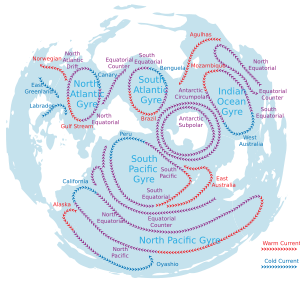Indian Ocean garbage patch facts for kids
The Indian Ocean garbage patch is a huge area in the central Indian Ocean where lots of plastic waste and other trash collects. It was found in 2010. This patch is part of the Indian Ocean Gyre, which is like a giant swirling current of water. There are five main ocean gyres around the world, and each one can collect trash.
Imagine it not as a solid island of trash, but more like a 'plastic soup.' The plastic breaks down into tiny pieces, so small you can't even see them without special tools. These tiny plastic bits, along with some chemicals, float in the water. Scientists estimate there can be about 10,000 tiny plastic pieces in just one square kilometer of water!
How the Indian Ocean Garbage Patch Was Found
Scientists first predicted that a large trash patch would exist in the Pacific Ocean back in 1988. This idea came from research done between 1985 and 1988. Researchers in Alaska measured tiny plastic pieces floating on the surface of the North Pacific Ocean.
Later, scientists noticed a lot of plastic trash washing up on beaches around the Indian Ocean. This made them think that there must be plastic floating in the water there too.
It's hard for researchers to find exactly where the trash piles up because of strong ocean currents. For example, plastic from Asia travels across the Indian Ocean to places like the western Indian Ocean islands and eastern Africa. This happens because of currents like the South Equatorial Current.
Sadly, about 90% of the trash found in these ocean patches is plastic. This is very harmful to ocean animals. When plastic washes ashore, it also affects the health of living creatures on land.
The 5 Gyres Project Discovers the Patch
In 2010, a group called the 5 Gyres Project started a series of trips across the oceans. They wanted to see if the South Atlantic, South Pacific, and Indian Ocean gyres also had trash patches, just like the North Pacific and North Atlantic.
During their trip through the Indian Ocean, they traveled about 4,800 kilometers (about 3,000 miles) between Perth, Australia and Port Louis, Mauritius. Every single water sample they collected during this journey contained plastic.
Their findings showed that the South Atlantic, South Pacific, and Indian Ocean gyres were indeed affected in the same way. Anna Cummins, who helped start the 5 Gyres Institute, described the pollution they found as "a thin plastic soup."
Raising Awareness About Ocean Trash
To help people understand this problem, an artist named Maria Cristina Finucci created something called the garbage patch state. She launched it at UNESCO in Paris on April 11, 2013. This was the first of many events supported by UNESCO and the Italian Ministry of the Environment to make people aware of ocean trash.
See also
 In Spanish: Mancha de basura del Océano Índico para niños
In Spanish: Mancha de basura del Océano Índico para niños



